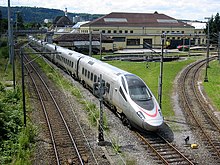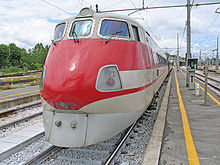Pendolino


Pendolino (from Italian pendolo : pendulum ) is the brand name for multiple units with electric drive distributed over several cars and active tilting technology from Alstom . Tilting technology enables trains to go faster in curves than conventional trains . The "TILTRONIX" tilting technology developed by Fiat works electro-hydraulically.
The first Pendolino generation is the ETR 401 , the second generation represents the ETR 450 alone , the third generation is the ETR 460 and the variants derived from it ETR 470 for Switzerland, the three-system version ETR 480 and ETR 485 as well as the versions for the Czech and Finnish railway companies . The counting of the generations is guaranteed by the manufacturer of the trains, the ETR 600 / 610 referred to as the fourth generation.
ETR is the abbreviation of "ElettroTreno Rapido" or "Electric Express Train".
Tilting technology trains that do not come from Fiat are also popularly referred to as "Pendolinos" (see section below ).
history
Beginnings
The history of the Pendolino trains began in 1969 with the development of the ETR 401, which was used as a pure test train with two power cars and two intermediate cars to test the active tilting technology and, equipped with passenger seats in 1978, remained in service between Rome and Ancona until 1983 .
Second generation
After these successful attempts, the ETR 450 was ordered in a series in 1984, the first copies of which were delivered in 1985 and started operation on the new Italian line from Rome to Rimini in 1988 and were reproduced until 1992. The ETR 450 is approved for a top speed of 250 km / h and can technically reach up to 280 km / h on the flat.
Third generation
Its successor, the ETR 460, became an internationally successful model, which was followed by the ETR 470 and the latest variants, the ETR 480 and ETR 485. The ETR 470 was used for transalpine traffic to Milan until 2014, operated by the Italian-Swiss joint venture Cisalpino until 2009 . At times these trains were also used on the Zurich - Stuttgart route. In addition to the Italian electricity system , the energy supply can also take over the one that is common in Switzerland (15 kV at 16.7 Hz). The ETR 480 is ready to be upgraded to 25 kV at 50 Hz and ETCS Level 2 , the power system used on the newer high-speed lines in Italy . The ETR 485 is equipped for this power system from the start.
Three of the ten ETR 460s are not only set up for the Italian traction power supply with 3,000 volts direct current , but also for 1,500 volts direct current for international traffic to southern France .
The ETR 460 was also sold to the Czech Republic as the ČD series 680 , to Slovenia as the SŽ series 310 and to Finland as the Sm3 . The Finnish variant has a wider track width . Ten units of this multiple unit with the wider Iberian gauge were built for the Spanish RENFE in the Spanish plants of Alstom and FIAT Ferroviario as class 490 . They are used as the Alaris train category . For the same gauge, Alstom in Amadora, Portugal, built ten trains for the Portuguese railway company as Alfa Pendular (Series 4000), which will be put into service from 1999.
According to an announcement in April 2016, the Czech Pendolinos will be equipped with ETCS . This replaces ETCS equipment installed when the trains were delivered.
Fourth generation
The fourth generation of the Pendolino is the ETR 600 and its variant with three power systems, the CIS ETR 610 .
On May 30, 2011, Alstom announced the purchase of 20 New Pendolino trains by the Polish PKP Intercity . These trains are built without tilting technology. The order is worth EUR 665 million and includes not only the delivery of the trains, but also the construction of a new depot in Warsaw and the maintenance of the trains for 17 years. The first vehicle of the PKP series ED250 was presented on June 17, 2013. The trains have been in scheduled operation since December 14, 2014.
Fifth generation
As a result of the 2014 revised technical specifications for interoperability , the Pendolino is also being developed.
The first customer of this revised version with redesigned front sections is the Italian railway company NTV . The first order for 12 seven-car trains with the designation ETR.675 Pendolino EVO was placed in October 2015, followed by an option for five more trains in September 2016. Finally, another five vehicles were ordered in July 2018, making this fleet a total of 22 trains. Their maintenance is carried out by the manufacturer Alstom Ferroviaria for a period of 30 years from delivery 2017 to 2018. In addition to 479 seats, there are also two wheelchair spaces. Scheduled operation of the Pendolino EVO began with the timetable change in December 2017.
Overview
| Type | generation | Years of construction | train | number | Manufacturer | dare | Vmax | length | Empty mass | Continuous output | comment |
|---|---|---|---|---|---|---|---|---|---|---|---|
| ETR 401 | 1 | 1969 | FS | 1 | Fiat Ferroviaria | 4th | 250 km / h | 105.9 m | 161 t | 1,800 kW | Experimental train |
| ETR 450 | 2 | 1985-1992 | FS | 15th | Fiat Ferroviaria | 8 or 9 | 250 km / h | 234 m | 435 t | 5,008 kW | retrofitted dining car |
| ETR 460 | 3 | 1993-1995 | FS | 10 | Fiat Ferroviaria | 8th | 250 km / h | 236 m | 440 t | 5,880 kW | 3 pieces additional with 1500 V direct current |
| ETR 470 | 3 | 1993-1996 | Cisalpino | 9 | Alstom Ferroviaria, Alstom Sesto | 9 | 200 km / h | 236.6 m | 451 t | 5,880 kW | additional equipped for 15 kV, 16.7 Hz; 2009 after the dissolution of Cisalpino AG: 5 Trenitalia 4 SBB |
| Sm3 | 3 | 1995-2006 | VR | 18th | Fiat Ferroviaria Rautaruukki-Transtech |
6th | 220 km / h | 158.9 m | 328.0 t | 4,000 kW | based on ETR 460 |
|
ETR 480 ETR 485 |
3 | 1997-1998 | Trenitalia | 15th | Fiat Ferroviaria | 9 | 250 km / h | 236.6 m | 409 t | 5,880 kW | Re-drawing in ETR 485 after additional Equipment for 25 kV, 50 Hz |
| 490 series | 3 | 1998-1999 | RENFE | 10 | GEC Alsthom, Fiat-SIG, Parizzi | 3 | 220 km / h | 81.2 m | 171.0 t | 1,960 kW | based on ETR 460 |
| Series 4000 | 3 | 1999-2000 | CP | 10 | Fiat, ADtranz, Siemens | 6th | 220 km / h | 158 m | 298 t | based on ETR 460 | |
| 310 series | 3 | 2000 | SZ | 3 | Fiat | 3 | 200 km / h | 81.2 m | 171 t | 1,960 kW | based on ETR 460 |
| Series 680 | 3 | 2003-2005 | CD | 7th | Alstom Ferroviaria | 7th | 230 km / h | 185.3 m | 384.0 t | 3,920 kW | based on ETR 470 |
| ETR 600 | 4th | 2007 - | Trenitalia | 12 | Alstom | 7th | 250 km / h | 187.4 m | 387 t | 5,500 kW | additional Equipped for 25 kV, 50 Hz |
|
ETR 610 / RABe 503 |
4th | 2007 - | Cisalpino | 14th | Alstom | 7th | 250 km / h | 187.4 m | 387 t | 5,500 kW | additional equipped for 25 kV, 50 Hz and 15 kV, 16.7 Hz; 2009 after the dissolution of Cisalpino AG: 7 Trenitalia 7 SBB (as RABe 503) |
| SBB RABe 503 | 4th | 2012/2015 | SBB | 8 + 4 | Alstom | 7th | 250 km / h | 187.4 m | 387 t | 5,500 kW | 25 kV / 50 Hz & 15 kV / 16.7 Hz Special feature: Lighter restaurant car to maintain the axle load in low- voltage operation |
| ED250 | 4th | 2014 - | PKP Intercity | 20th | Alstom | 7th | 250 km / h | 187.4 m | 395.5 t | 5,664 kW | without tilting technology, voltage systems: 3000 V DC, for 25 kV, 50 Hz and 15 kV, 16.7 Hz |
| ETR. 675 | 5 | since 2016 | NTV | 22nd | Alstom Ferroviaria | 7th | 250 km / h | 187.3 m | 407 t | 5,500 kW | without tilting technology, compliance with TSI 2014, voltage systems: 3000 V DC and 25 kV, 50 Hz |
Special forms
A "Pendolino Britannico" was developed for intercity traffic on the West Coast Main Line in Great Britain , the car body of which differs significantly from all others because it had to be adapted to the smaller British clearance profile . These multiple units are run as British Class 390 .
The CRH5 of the Chinese railways is very similar to the ETR 600, but with a wider car body and without tilting technology .
Trains from other manufacturers with Fiat tilting technology
In the vernacular also tilting trains that do not come from Fiat and Alstom, referred to as "Pendolino"
- Germany: Class 610 and ICE T
- Switzerland: SBB RABDe 500 / ICN
Another widespread system with tilting technology that does not come from Fiat or Alstom is the Spanish Talgo Pendular.
Individual evidence
- ↑ 2012 timetable change: In three hours from Basel to Paris - ETR 470 until the end of 2014. September 17, 2011, accessed on January 7, 2019 (German).
- ↑ The ČD trains will be equipped with the European ETCS train control system. In: ceskedrahy.cz. České dráhy , April 14, 2016, accessed on April 23, 2016 .
- ↑ ČD are planning major vehicle investments . In: Eisenbahn-Revue International . No. 6 , 2016, ISSN 1421-2811 , p. 285 .
- ↑ Alstom Press Release, May 30, 2011: Alstom to supply and maintain a fleet of 20 New Pendolino trains for PKP Intercity ( Memento of the original from June 11, 2011 in the Internet Archive ) Info: The archive link was inserted automatically and has not yet been checked. Please check the original and archive link according to the instructions and then remove this notice.
- ^ Railway Gazette International, June 20, 2013: First Polish Pendolino presented to PKP Intercity
- ↑ Inauguracja nowego rozkładu jazdy on rozklad-pkp.pl (Polish), accessed on December 25, 2014.
- ↑ Alstom (2015): Alstom and NTV sign a contract for the purchase of 8 Pendolino high-speed trains, and 20 years of maintenance . accessed on September 24, 2016.
- ↑ Alstom (2016): Alstom to deliver four additional Pendolino high-speed trains and related maintenance services to NTV . accessed on September 24, 2016.
- ↑ Alstom (2016): data sheet of the variant for NTV . PDF file (306 kB). accessed on September 24, 2016.
- ↑ Archived copy ( memento of the original from January 25, 2015 in the Internet Archive ) Info: The archive link was inserted automatically and has not yet been checked. Please check the original and archive link according to the instructions and then remove this notice.
- ↑ http://www.railwaygazette.com/news/ passtger/single-view/view/pkp-intercity-signs- pendolino-contract.html
- ↑ http://www.br.de/nachrichten/mittelfranken/inhalt/pendolino-ausgemustert-db-museum-100.html ( Memento from January 8, 2015 in the Internet Archive )
- ↑ http://www.lokifahrer.ch/Lokomotiven/Loks-SBB/RABDe_500/SBB-ICN.htm
Web links
- Physics task for the Pendolino ( LEIFI -Physik)



